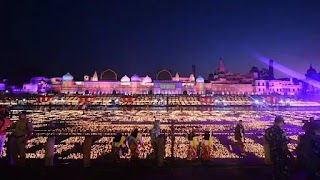Ayodhya is a city full of ancient legends, revered traditions and a rich cultural history. Ayodhya, nestled on the banks of the Sarayu River and located in Uttar Pradesh's northern state, is more than just a geographic location. It is a spiritual center that is alive with ancient legends.
**Historical Significance:**
Ayodhya is closely linked to the Ramayana, which was one of two great Sanskrit epics in ancient India. Ayodhya is described in the Ramayana as the capital of Kosala and ruled by King Dasharatha. Lord Rama's birthplace, as the seventh avatar and protagonist of the Ramayana, gained worldwide fame. Ram Janmabhoomi is a sacred place for Hindus around the world. It is believed to be where Lord Rama's birth took place.
**Religious Diversity:** Ayodhya, while primarily associated as a Hindu city, embraces religious diversity. Since centuries, it has been a melting-pot of different faiths. Hindus, Muslims and other groups have lived together in harmony. Its temples, shrines, and mosques reflect the city's rich cultural mosaic. Hanuman Garhi and Kanak Bhawan are revered Hindu sites. The Chhoti Devkali Temple, a Muslim site, is also important.
The Ayodhya Dispute Ayodhya received global attention because of the Ayodhya conflict, a social-political dispute over the Babri Masjid/Ram Janmabhoomi. The dispute centered on competing claims made by Hindus and Muslims about the ownership of the land. The Supreme Court of India issued a landmark verdict in 2019, resolving a long-standing dispute and awarding the land to Hindus so they can build a Ram Temple. An alternative site was allocated for a mosque. **Cultural Heritage:** Ayodhya's cultural heritage is rich beyond its religious significance. The architecture, festivals and traditional arts of the city reflect its grandeur. Ram Lila is a dramatic reenactment from the Ramayana that attracts both pilgrims and tourists. Ayodhya is known for its intricate carvings and vibrant festivals such as Diwali. It also has classical music and dance performances.
**Tourist Attractions:** Ayodhya has many landmarks that attract visitors looking for spiritual comfort and historical insight. Ramkot is a popular pilgrimage site, as it's believed to be where Rama built his fort. Popular attractions include the Guptar Ghat where Lord Rama allegedly took a swim and Treta Ke Thakur temple, which is dedicated to Lord Rama. The charm of the city extends beyond its religious sites. The scenic ghats that line the Sarayu River offer a peaceful retreat. **Modern Ayodhya:** Ayodhya underwent development initiatives in recent years to improve its infrastructure and promote tourist. The plans for the Ram Mandir are a stunning architectural feat and a new chapter is being written in Ayodhya’s history. It is hoped that the city will become a center for religious and cultural tourism, allowing visitors to experience its timeless appeal.
Ayodhya is a symbol for India's rich heritage, with its mix of spirituality, history and cultural riches. The significance of the city goes beyond religious boundaries and emphasizes the need for coexistence and harmony. Ayodhya is a city that continues to evolve and remains a beacon for the timeless values which have shaped India's subcontinent over millennia. It invites the world to witness this confluence between the past, present, and future in the sacred city of Sarayu.
.jpg)




No comments:
Post a Comment